Abstract
A series of six coordination polymers based on octahedral cluster anions [Re6Q8(CN)6]4− (Q = S or Se) and Ag+ cations coordinated by bipyridine analogs were synthesized under solvothermal conditions. Their structures have been characterized by single crystal X-ray diffraction. Compounds 1 and 2 described by the general formula [{Ag(phen)}4Re6Q8(CN)6] (Q = Se (1), S (2); phen = 1,10-phenanthroline) exhibit layered structures assembled into a supramolecular network by CH…π contacts. At the same time, compounds [{Ag(bipym)}2Ag2Re6Se8(CN)6] (bipym = 2,2′-bipyrimidine) (3), [{Ag2(bipy)}Ag2Re6Se8(CN)6]·CH3CN (bipy = 4,4′-bipyridine) (4) and [{Ag(dpbp)}4Re6Q8(CN)6]·2H2O·2CH3CN (Q = Se (5), S (6); dpbp = 4,4′-Di(4-pyridyl)biphenyl)) evince framework structures. In 1, 2, 5 and 6 weak Ag⋯Ag interactions are observed. All the compounds show luminescence in the red region. The luminescence quantum yields and lifetimes were found to be notably higher than those for most of the coordination polymers based on the octahedral rhenium cluster complexes.
1. Introduction
Hexanuclear rhenium cluster complexes have been an object of intensive research for the last two decades [1,2]. Such cluster complexes have a number of attractive properties: they exhibit intense red photoluminescence with microsecond emission lifetimes and possess high thermal and hydrolytic stability [3,4,5]. Reversible oxidation of {Re6Q8}2+ (Q = S, Se or Te) cluster core accompanied by luminescence quenching makes it possible to “switch off” the emission of compounds in controllable manner and construct chemical sensors [6,7]. Chalcocyanide cluster complexes [Re6Q8(CN)6]4− (Q = S, Se, Te) have all these fascinating properties and additionally possess six cyanide ligands, which are capable of forming covalent bonds with 3d and 4f metal cations [8,9,10,11]. The current trend in the chemistry of coordination polymers is directed to the design of compounds with interesting multifunctional properties, and the rhenium chalcocyanide clusters make very suitable building blocks for such purpose. It was shown earlier that coordination polymers (CPs) built on [Re6Q8(CN)6]4− anions transition metal cations and demonstrate weak emission with low quantum yields relative to simple salts of [Re6Q8(CN)6]4− with alkali metal or organic cations [12]. Therefore, the improvement of photophysical characteristics of CPs based on [Re6Q8(CN)6]4− can enhance their potential applicability as multifunctional materials. The combination of properties inherent for different building blocks and nodes is one of the common approaches for constructing compounds with predetermined properties.
In this work, Ag+ cations with the 2,2′-bipyridine, 4,4′-di- and 4,4′-bipyridine derivatives were introduced into the structure of CPs based on the [Re6Q8(CN)6]4− (Q = S, Se) anionic complexes. Compounds based on Ag+ ions are of interest due to electrical conductivity [13], biological activity [14] and, especially, emissive properties [15,16,17]. Diversity of coordination geometry of silver complexes makes such cations convenient nodes for constructing CPs with rich architectural varieties. In addition, the ability of Ag+ to form metal–metal interactions increases structural diversity and also influences the emission properties [18,19,20]. Despite the fact that Ag+-containing compounds have been known for a long time, their investigation was hampered for a long time due to low photostability. The number of compounds based on Ag+ cations and organic ligands had arisen drastically in the last two decades. Partially, it is associated with a great interest in a group of compounds exhibiting thermally activated delayed fluorescence (TADF). It is assumed that such compounds are promising for the new generation of OLEDS [21]. Silver, as a soft Lewis acid, has a good affinity to nitrogen. N-donor aromatic organic molecules are classical ligands for the synthesis of compounds based on Ag+ cations [22]. It was shown recently that compounds based on the cluster anions [Re6Q8(CN)6]4− (Q = S or Se) and [Ag(2,2′-bipy)]+ cations possessed spectral characteristics surpassing the characteristics of the initial cluster salts [23]. In particular, investigation of luminescence properties showed an increase in the quantum yield and lifetime of the obtained CPs. In this work, we describe the syntheses and characterization of six new coordination polymers based on the cluster anions [Re6Q8(CN)6]4− (Q = S or Se) and Ag+ complexes with bipyridine analogs. Structures, composition, spectroscopic and photophysical properties of the new compounds were investigated. A great effect of coordination of the Ag+ complexes on emission parameters of cluster anions was revealed.
2. Experimental Section
2.1. Materials and Methods
The starting cluster salts K4[Re6Se8(CN)6]·3.5H2O and Cs3K[Re6S8(CN)6]·2H2O were prepared as described [24,25]. Other reagents were used as purchased. Elemental analysis was made on a EuroVector EA3000 analyzer (EuroVector, Pavia, Italy). IR spectra in KBr pellets in the range 4000–375 cm−1 were recorded on a Bruker Scimitar FTS 2000 spectrometer (Bruker Corporation, Billerica, MA, USA). Energy dispersive spectroscopy (EDS) was performed on a Hitachi TM-3000 electron microscope equipped with a Bruker Nano EDS analyzer (Hitachi, Ltd., Chiyoda City, Tokyo, Japan). Powder X-ray diffraction (PXRD) was performed at room temperature on a Shimadzu XRD-7000 (Shinadzu, Kyoto, Japan) diffractometer (Cu Kα radiation, graphite monochromator). Room temperature excitation and emission spectra of powdered samples were recorded with a Horiba Jobin Yvon Fluorolog 3 photoluminescence spectrometer equipped with 450 W ozone-free Xe-lamp (Horiba, Ltd., Kyoto, Japan), cooled PC177CE-010 photon detection module (Hamamatsu Photonics K.K., Hamamatsu City, Shizuoka, Japan) with a PMT R2658 and double grating excitation and emission monochromators (Products for Research, Inc., Danvers, MA, USA). Excitation and emission spectra were corrected for source intensity (lamp and grating) and emission spectral response (detector and grating) by standard correction curves.
Single Crystal Diffraction Studies
Diffraction data for single crystals of 1–4 and 6 were collected with a Bruker Apex DUO (Bruker Corporation, Billerica, MA, USA) diffractometer equipped with a 4 K CCD area detector using the graphite-monochromated MoKα radiation (λ = 0.71073 Å) at 150 K. The φ- and ω-scan techniques were employed to measure intensities. Absorption corrections were applied with the use of the SADABS program [26]. The crystal structure was solved using the SHELXT [27] and were refined using SHELXL [28]. Diffraction data for single crystal 5 were obtained on an Agilent Xcalibur diffractometer equipped with a CCD AtlasS2 detector (MoKα, graphite monochromator, ω scans) (Agilent Technologies, Santa Clara, CA, USA). Integration, absorption correction and determination of unit cell parameters were performed using the CrysAlisPro program package [29]. Positions of hydrogen atoms of organic ligands were calculated geometrically and refined in the riding model. The crystallographic data and details of the structure refinements are summarized in Table S1. Selected bond distances are shown in Table S2. CCDC 2212912–2212917 contain the crystallographic data for compounds 1–6, respectively. These data can be obtained free of charge from The Cambridge Crystallographic Data Centre via www.ccdc.cam.ac.uk/structures (accessed on 14 October 2022)
2.2. Syntheses
Synthesis of [{Ag(phen)}4Re6Se8(CN)6] (1). 1,10-phenanthroline (15 mg, 0.083 mmol) was dissolved in 2 mL of EtOH. KAg(CN)2 (10 mg, 0.050 mmol) was dissolved in 1 mL of distilled H2O. Solution of K4[Re6Se8(CN)6]·3.5H2O (25 mg, 0.011 mmol) in 1 mL of H2O was placed in a glass ampoule, then K[Ag(CN)2] and phen solutions were sequentially added. The ampoule was sealed and heated at 140 °C for 48 h. Rhomboid crystals were formed on the bottom of the ampoule. Yield: 21 mg (63% based on [Re6S8(CN)6]4− anion). FT-IR (νmax, cm−1): ν(CN)—2133, 2121; phen—3047, 1620, 1585, 1568, 1508, 1423, 1338, 1256, 1219, 1136, 1097, 840, 769, 729, 630. Anal. calcd (%) for C54H32Ag4N14Re6Se8: C, 21.21; H, 1.05; N, 6.41. Found: C, 21.50; H, 1.10; N, 6.50. EDS: Ag:Re:Se = 3.8:6.0:8.2.
Synthesis of [{Ag(phen)}4Re6S8(CN)6] (2). Compound 2 was synthesized using the same procedure as for 1 except using Cs3K[Re6S8(CN)6]·2H2O (25 mg, 0.011 mmol). Yield: 11 mg (37% based on [Re6S8(CN)6]4− anion). FT-IR (νmax, cm−1): ν(CN)—2140, 2117; phen—3049, 1618, 1587, 1558, 1508, 1421, 1338, 1219, 1137, 1095, 842, 729, 630. Anal. calcd (%) for C54H32Ag4N14Re6S8: C, 24.18; H, 1.20; N, 7.31; S, 9.56. Found: C, 24.30; H, 1.20; N, 7.40; S, 9.70. EDS: Ag:Re:S = 3.8:6.0:8.2.
Synthesis of [{Ag(bipym)}2Ag2Re6Se8(CN)6] (3). 2,2′-bipyrimidine (10 mg, 0.163 mmol) was dissolved in 2 mL of EtOH. K[Ag(CN)2] (10 mg, 0.050 mmol) was dissolved in 1 mL of distilled H2O. Solution of K4[Re6Se8(CN)6]·3.5H2O (25 mg, 0.011 mmol) in 1 mL of H2O was placed in a glass ampoule, then K[Ag(CN)2] and 2,2′-bipyrimidine solutions were sequentially added. The ampoule was sealed and heated at 140 °C for 40 h. Several red rhomboid crystals were formed on the bottom of the ampoule mixed with crystalline white powder and amorphous gray powder. A crystal for single-crystal X-Ray diffraction studies was selected manually. EDS: Ag:Re:Se = 4.1:6.0:8.1.
Synthesis of [{Ag2(bipy)}Ag2Re6Se8(CN)6]·CH3CN (4). 4,4′-bipyridine (20 mg, 0.128 mmol) was dissolved in 1 mL of EtOH. KAg(CN)2 (10 mg, 0.050 mmol) was dissolved in 1 mL of distilled H2O. Solution of K4[Re6Se8(CN)6]·3.5H2O (20 mg, 0.011 mmol) in 1 mL of H2O was placed in a glass ampoule, then K[Ag(CN)2] and 4,4′-bipydine solutions as well as 1 mL of CH3CN were sequentially added. Resulted solution turned cloudy. The ampoule was sealed and heated at 140 °C for 72 h. As a result, the solution became clear. Then ampoule was left in the dark place for 240 h. Several needle-like crystals were formed mixed with crystalline white powder and amorphous black powder. Crystal for single-crystal X-Ray diffraction studies was selected manually. EDS: Ag:Re:Se = 3.9:6.0:8.2.
Synthesis of [{Ag(dpbp)}4Re6Se8(CN)6] 2H2O·2CH3CN (5). For the synthesis of the compound, two ampoules sealed together with a common neck were used (Figure 1). 4,4′-Di(4-pyridyl)biphenyl (bpbp) (25 mg, 0.081 mmol) was placed in one ampoule together with solutions of K4[Re6Se8(CN)6]·3.5H2O (25 mg, 0.011 mmol) in 1 mL of H2O and K[Ag(CN)2] (10 mg, 0.050 mmol) in 1 mL of H2O. Additionally, 1 mL of EtOH and 1 mL of CH3CN were added to the ampoule. The neck was then sealed and the double ampoule was left in the furnace at 150 °C. After 2 weeks, flat square crystals formed at the bottom of the ampoule with reagents. The hot mother solution was carefully poured into the second ampoule resulting in the pure crystalline product 5. Crystals were washed with H2O and dried on the air. Yield: 14 mg (35% based on the [Re6Se8(CN)6]4− anion). FT-IR (νmax, cm−1): ν(CN)—20112, 2090; dpbp—1604, 1558, 1541, 1508, 1473, 1458, 1419, 1396, 1261, 1068, 1004, 804, 756, 669, 557. Anal. calcd (%) for C94H64Ag4N14Re6Se8: C, 31.91; H, 2.02; N, 6.07. Found: C, 32.1; H, 2.10; N, 6.00. EDS: Ag:Re:Se = 4.0:6.0:8.1.
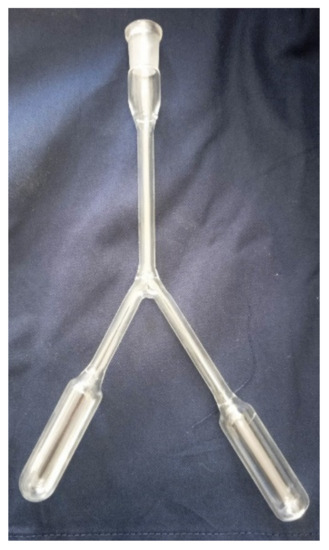
Figure 1.
Double ampoule for the synthesis of the compounds 5 and 6.
Synthesis of [{Ag(dpbp)}4Re6S8(CN)6]·2H2O·2CH3CN (6). Compound 6 was synthesized using the same procedure as for 5 except using Cs3K[Re6S8(CN)6]·2H2O (25 mg, 0.011 mmol) as starting cluster salt. Yield: 5 mg (14% based on [Re6S8(CN)6]4− anion). FT-IR (νmax, cm−1): ν(CN)—2113, 2090; dpbp—1604, 1558, 1541, 1506, 1481, 1458, 1417, 1396, 1338, 1224, 1066, 1004, 804, 756, 669, 559. Anal. calcd (%) for C94H64Ag4N14Re6S8: C, 35.53; H, 2.25; N, 6.76; S, 7.74. Found: C, 35.80; H, 2.30; N, 6.50; S, 7.70. EDS: Ag:Re:Se = 3.9:6.0:8.2.
3. Results and Discussion
3.1. Synthesis
Relatively few compounds based on cyanometallates and silver cations are known. There are even fewer examples when [Ag(CN)2]− acts as a source of silver cations in such syntheses [30,31]. In the case of octahedral cluster cyanide complexes, the choice of the silver source was found to be critical for the preparation of crystalline coordination polymers with organic ligands. The coordination polymers 1–6 were obtained by a solvothermal synthesis as a result of the interaction of [Ag(CN)2]−, [Re6Q8(CN)6]4− (Q = S or Se) and corresponding organic ligands in water/organic solvent mixtures. It should be noted that, according to the results of IR spectroscopy, all CN-groups in the obtained compounds are equivalent. The frequency of ν(CN) vibration is 2125–2155 cm−1 matching well the corresponding frequencies in other coordination polymers based on [Re6Q8(CN)6]4− (Q = S, Se) cluster anions [7,32]. It can be assumed that the stage of destruction of the [Ag(CN)2]− anion is the limiting one and determines the reaction rate, while the coordination of Ag+ cations to the cluster complex occurs very quickly. Indeed, the introduction of simple salts, such as silver nitrate, instead of K[Ag(CN)2] into the reaction mixtures led to immediate formation of amorphous products, which, according to elemental analysis, did not contain organic ligands. We propose that use of [Ag(CN)2]− increases the ability of organic ligands to compete for silver coordination sites with the cyano-groups of the cluster complexes.
3.2. Crystal Structures
Compound 1 crystallizes as rhomboidal plates in the triclinic space group P1. The asymmetric units of compound 1 (Figure 2) contain half of [Re6Se8(CN)6]4− cluster anion, two Ag+ ions and two phenanthroline ligands. The geometric parameters of [Re6Se8(CN)6]4− cluster anion are typical and correlate well with the literature data (Table S2). The coordination environment of Ag1 atom includes two nitrogen atoms of the CN-groups and two N atoms of the phenanthroline molecule with the formation of distorted square planar geometry (Figure 3a). Ag1–N1 distances (between Ag1 atom and two N atoms of cyanide groups of adjacent cluster complexes) are 2.26 and 2.67 Å. The last distance is longer probably due to the bridge coordination of N atom of cyanide group (Figure 4). Ag1–N101 and Ag1–N102 distances are equal to 2.32 and 2.44 Å, respectively. The environment of Ag1 is completed by another Ag1 atom located at a distance of 3.25 Å (Figure 4), which corresponds to a weak argentophilic interaction [17]. The coordination environment of Ag2 atom includes two N atoms of the cyano-groups and two N atoms of the phenanthroline molecule. The coordination polyhedron is a distorted tetrahedron (Figure 3b). Distances between phen N201 and N202 atoms and Ag2 atom are equal to 2.32 and 2.39 Å; cyanide groups form Ag2–N2 and Ag2–N3 bonds with lengths of 2.37 and 2.14 Å, respectively. In the structure, cluster complexes are linked in a chain via four Ag1 atoms pairwise connected by N atoms of bridged cyanide l (Figure 4). The chains extend parallel to each other and are linked by Ag2 atoms ([Ag(phen)]+ complexes) bonded to the clusters cyanide groups of adjacent chains (Figure 5). A number of CH…π interactions between phenanthroline aromatic rings generate frameworks without an empty space accessible for solvate molecules (Figure 6).
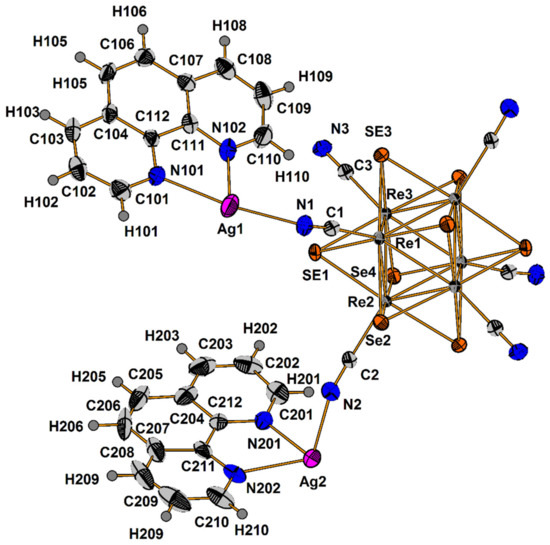
Figure 2.
ORTEP drawing of the asymmetric unit in the structure of 1. Thermal ellipsoids of 75% probability.
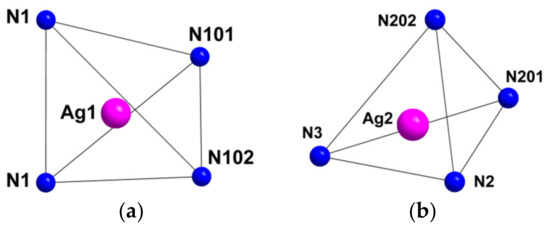
Figure 3.
Coordination polyhedra of Ag1 (a) and Ag2 (b) atoms.

Figure 4.
Fragment of compound 1.
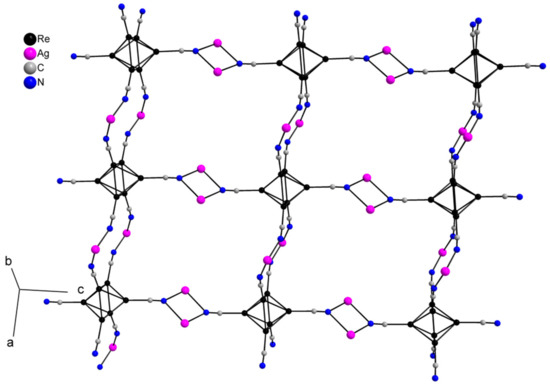
Figure 5.
A layer structure of compound 1. Se atoms and phen molecules are omitted for clarity.
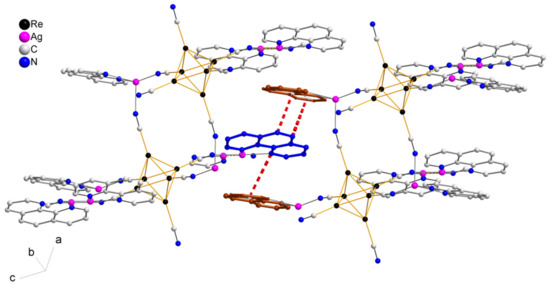
Figure 6.
A scheme of CH…π interactions between phenanthroline aromatic rings.
Compound 2 is isostructural to compound 1. The main geometric characteristics of compound 2 are presented in Tables S3 and S4.
1,10-phenanthroline is a common chelating N-donor ligand for 3d and 4f metals. Silver-based compounds are no exception. More than 200 compounds based on silver cations and phenanthroline or its derivatives with various additional ligands are presented in the literature [33,34,35]. At the same time, there are only a few examples of compounds with 1,10-phenanthroline that have argentophilic interactions. Among them, a number of compounds can be distinguished where the formation of argentophilic interactions was facilitated by π–π interactions between phenanthroline molecules of neighboring cationic complexes [Ag(phen)n]+ [36,37,38,39,40,41]. It could be expected that the formation of π-stacking between phenanthroline molecules coordinated to Ag+ ions would favor the formation of argentophilic interactions in the structures of compounds 1 and 2. However, in the dimeric cationic complex (phen)Ag⋯Ag(phen), the phenanthroline molecules lie in the same plane, which makes it impossible for stacking to form between them (Figure 5). Thus, phenanthroline acts as a bulky ligand that blocks some of the coordination sites of the silver atom [42,43,44], and the formation of argentophilic interactions may occur due to packing effects. The formation of the argentophilic interactions in compounds 1 and 2 could also be facilitated by μ mode of N donor atom of cyanide group.
Compound 3 crystallizes in orthorhombic space group Pbca. The asymmetric unit contains half of [Re6Se8(CN)6]4− cluster anion, one Ag+ cation disordered over two close positions (Ag1 and Ag2 with 0.85 and 0.15 occupancies, respectively), one Ag+ with the full occupancy, four N and eight C atoms of 2,2′-bypirimidine (bipym) ligand (Figure 7). Coordination environment of Ag+ in the Ag1 position includes two N atoms (N11 and N12) of the bipym molecule and two N atoms (N1 and N3) of cyanide groups. Ag1–N1 and Ag1–N3 distances are equal to 2.33 and 2.21 Å, while Ag1–N11 and Ag1–N12 distances—2.46 and 2.49 Å, respectively. Coordination polyhedron is a distorted tetrahedron (Figure 8a). Coordination environment of Ag2 is represented by two N atoms of two cyanide groups and two N atoms of bipym. Ag2–N1 and Ag2–N3 distances are equal to 2.43 and 1.99 Å. It should be noted that the Ag2–Nbipym distances are 2.137 and 2.731 Å, which indicates a weak contact in the second case. With this elongated Ag2–N bond taken into account, the coordination number of Ag2 is 4, and the coordination polyhedron is a strongly distorted tetrahedron (Figure 8b). Coordination environment of Ag3 atom is presented by two N atoms (N21 and N22) of bipym ligand, two Se atoms, one N (N1) and one C atoms of cyanide ligands. The bond lengths of Ag3–N1, Ag3–N21 and Ag3–N22 are 2.31, 2.39 and 2.56 Å, respectively. The Ag–Se bond lengths are 2.87 and 3.04 Å implying the formation of relatively strong chalcophilic interactions. Ag3–C2 bond length is equal to 2.49 Å. Coordination polyhedron around Ag3 is trigonal prism (Figure 8c). Coordination environment of the cluster complex includes 8 Ag atoms (Figure 9). Two of the cyanide groups act as μ-N-donor ligands binding Ag1 and Ag3 atoms; two cyanide groups bind one Ag1 atom. Additionally, two Ag3 atoms form bonds with two Se atoms and C atom (Figure 9). Thus, a pseudocubic crystal structure is formed (Figure 10). Additionally, Ag1 and Ag3 atoms linked via bipym molecule. It is noteworthy that there is no π-stacking between aromatic rings or argentophilic interactions in the structure.
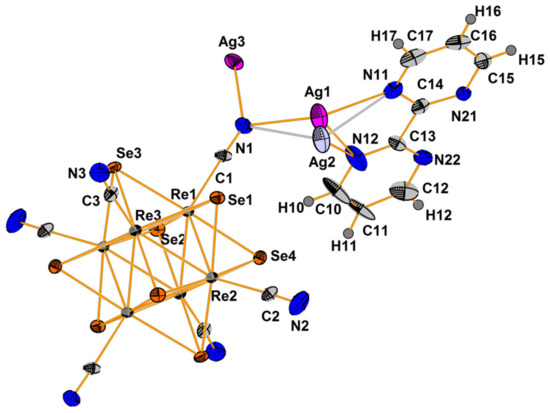
Figure 7.
ORTEP drawing of the asymmetric unit in the structure of 3. Thermal ellipsoids of 75% probability.

Figure 8.
Coordination polyhedra of Ag1 (a), Ag2 (b) and Ag3 (c) atoms.

Figure 9.
Coordination environment of cluster complex in the structure of compound 3.
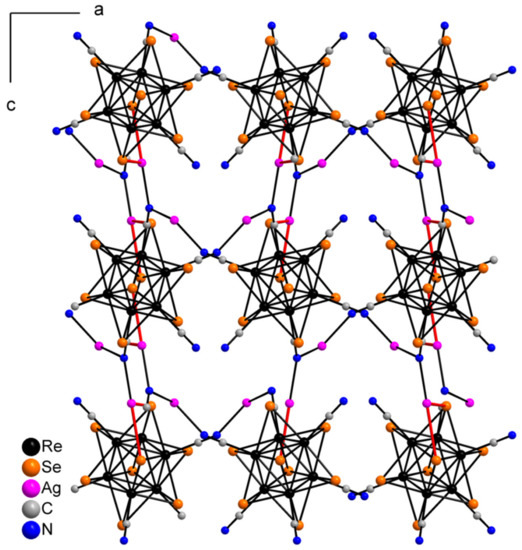
Figure 10.
A fragment of framework in 3. bipym ligands are omitted for clarity.
The number of reported compounds based on Ag+ cations and 2,2′-bipyrimidine is rather small. Without the inclusion of additional ligands, compounds of such type have chain (1D) polymeric structures, and in the chains bipym ligand link two metal centers [45,46,47,48]. The introduction of additional bridging ligands, such as oxalate, can also lead to the formation of 1D structures [45,48]. Small clusters, like [Cp2Mo2(CO)4(η2-P2)], can act as a coligand resulting in the formation of layered structures [49]: 2,2′-bipyrimidine links silver atoms to form chains, and the chains are connected into layers by the organometallic complex [Cp2Mo2(CO)4(η2-P2)]. For one compound, described in [49], argentophilic interactions are mentioned. It should be noted that this is the only example of a coordination polymer based on silver cations and 2,2′-bipyrimidine, in which the presence of argentophilic interactions was revealed. It should also be noted that there are no framework compounds among coordination polymers built from Ag+ and bipym.
Compound 4 crystallizes in monoclinic crystal system, C2/m space group. The asymmetric unit is presented by two Re atoms, three Se atoms, two N and C atoms of cyanide groups, two Ag atom and one ring (five C, one N and four H atoms) of 4,4′-bypiridine (Figure 11). Besides, one solvate molecule of acetonitrile is presented. The coordination environment of Ag1 atom includes two N11 atoms of bipy and one N2 atom of cyanide group with bond length equal to 2.23 and 2.47 Å, respectively. Additionally, Ag1 forms a long bond with the N2 atom of the adjacent cluster complex with length equal to 2.68 Å. The coordination polyhedron is a distorted tetrahedron (Figure 12a). The coordination environment of Ag2 atom consists of two N atoms of cyanide groups (dAg–N = 2.14 Å) and one Se atom (dAg–Se = 2.78 Å). Moreover, the Ag2 atom forms a bond with the C atom of cyanide group of the neighbouring cluster complex with dAg–C = 2.50 Å. The coordination polyhedron is a distorted tetrahedron (Figure 12b). The cluster complex bonds six Ag atoms via cyanide groups. Two Ag1 atoms are apical, and four Ag2 atoms are bridging. Ag1 atoms are linked via bipy ligands. Thus, a polymeric ribbon (1D structure) is formed (Figure 13). Each cluster complex forms two Ag–Se bonds with two Ag atoms of the neighboring ribbons. Additionally, Ag1 and Ag2 atoms form bonds with N1 and C1 atoms of the neighboring ribbons forming a framework (Figure 14). It should be noted that there are no π–π interactions between aromatic rings of 4,4′-bipyridine molecules or argentophilic interactions in the structure 4.

Figure 11.
ORTEP drawing of the asymmetric unit in the structure of 4. Thermal ellipsoids of 75% probability.
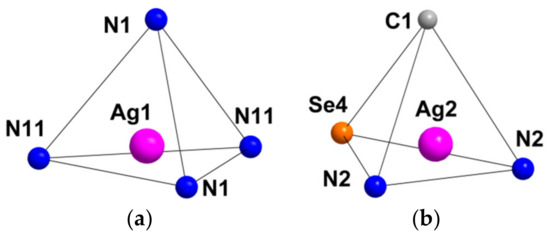
Figure 12.
Coordination polyhedral of Ag1 (a) and Ag2 (b) atoms in the structure of 4.
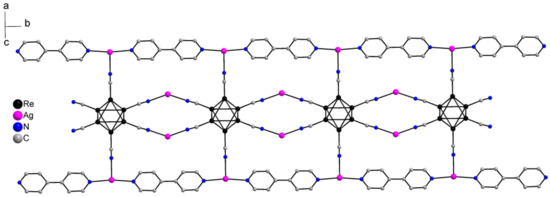
Figure 13.
A fragment of the polymeric ribbon compound 4.
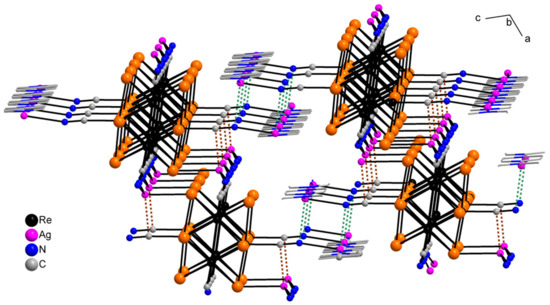
Figure 14.
A framework fragment of compound 4. Green dotted lines are Ag–N bonds. Red dotted lines are Ag–C bonds.
4,4′-bipyridine is a common ligand for the synthesis of compounds based on 3d metals.
Usually, the binding of silver cations by bipyridine molecules results in the formation of polymeric chains [Ag(bipy)]+n, i.e., 1D structures, which have linear or zigzag shapes depending on the coordination environment of Ag+. There are numerous compounds in the literature that include such moieties. To increase the dimensionality of a structure, various polydentate ligands are introduced. Presence of aromatic rings of the ligand forming π–π interactions often promote formation of argentophilic interactions in such structures [50,51]. The inclusion of bidentate ligands may not lead to increase of the dimensionality of the coordination polymer. The ligand linking two [Ag(bipy)]+n chains through silver atoms forms one-dimensional ladder motifs, which are further bonded into a layer through π–π interactions between bipyridyl aromatic rings and argentophilic interactions [52,53,54]. In addition, bidentate ligands can coordinate two silver atoms of [Ag(bipy)]+n chains located parallel to each other and linked by π–π interactions, stabilizing argentophilic interactions without leading to an increase in the dimension of the coordination polymer [55]. Bulky, rigid and long linkers make it possible to obtain layers, which form a supramolecular framework due to the presence of π–π interactions between bipyridine molecules [54,56]. At the same time, argentophilic interactions can be formed between the silver atoms of neighboring layers, which also stabilize the packing [57]. The number of framework (3D) compounds based on silver cation and 4,4′-bipyridine is small. For example, a framework compound was obtained by introducing 3,5-(di(2′,5′-dicarboxylphenyl)benozoic acid, where each ligand coordinates four silver atoms [58]. It is also worth highlighting a number of works on the synthesis of compounds based on polyoxometalates (POMs) and silver cations. Among them, there are compounds where POMs acted as a coligand, binding [Ag(bipy)]+n chain motifs. For example, in the work of H. Yang et al., [PW12O40] acts as an octadentate ligand, while linking six [Ag(bipy)]+n chains through oxygen atoms into a framework [59]. Similarly, such POMs as [Mo5P2O23], [SiW12O40] and [GeW12O40], acting as hexadentate ligands, coordinate the silver atoms of the [Ag(bipy)]+n chains to form 3D structures [60,61]. In comparison with such POMs as [SiW12O40] and [GeW12O40], the cluster complex is much smaller, which could explain the binding of only two [Ag(bipy)]+n chains. It is noteworthy that [Mo5P2O23] has comparable size with the [Re6Q8(CN)6]4− cluster. However, all six [Ag(bipy)]+n chains linked to [Mo5P2O23] in such a way that their mutual arrangement is almost parallel to each other, which is sterically impossible in the case of the hexarhenium cluster complex.
The asymmetric unit of compound 5 contains three Re atoms of the cluster core, three cyanide ligands, four μ3-Se ligands, two Ag+ cations and two dpbp ligands (Figure 15). The coordination environment of Ag1 includes two N atoms of two different dpbp ligands (N11 and N12), one N atom of a cyanide group (N1) and one Se atom. Ag1–N11, Ag–N12 and Ag1–N1 bond lengths are equal to 2.2, 2.21 and 2.50 Å, respectively. The Ag1–Se1 bond length is equal to 3.06 Å. Ag1 is tetra-coordinated with the geometry of coordination environment close to square planar (Figure 16a). The coordination environment of Ag2 atom includes two N atoms of two dpbp ligands and one N atom of a cyanide group. The Ag–N distances are equal to 2.177 and 2.164 Å in the case of dpbp ligands and 2.62 Å for CN group. Three coordinated Ag2 with Ndpbp–Ag–Ndpbp angles equal 176.6° and have a T-shaped environment (Figure 16b). The coordination environment of the cluster complex is presented by four Ag atoms (two Ag1 and two Ag2) bonded to cyanide groups. Silver atoms, in turn, are linked in chains by N atoms of dpbp ligand. Thus, four [AgL]+n polymeric chains linked by the cluster complexes form a one-dimensional [(Ag(dpbp))4[Re6Se8(CN)6]n fragment (Figure 17 and Figure 18). Such chains are bound into a framework due to numerous Ag–Se bonds (Figure 19). Each cluster complex provides two selenium atoms for bonding with two silver atoms of two neighboring chains. There are very weak Ag⋯Ag interactions in the structure. The distance between two Ag2 atoms is 3.29 Å, which is close to the sum of van der Waals radii of 3.44 Å.

Figure 15.
ORTEP drawing of the asymmetric unit in the structure of 5. Thermal ellipsoids of 75% probability.
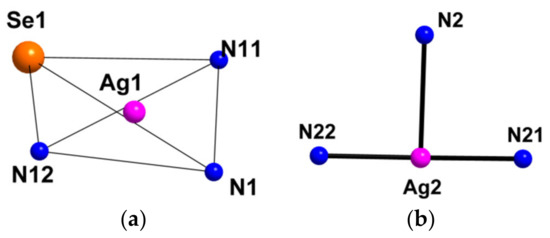
Figure 16.
Coordination polyhedral of Ag1 (a) and Ag2 (b) atoms in the structure of compound 5.
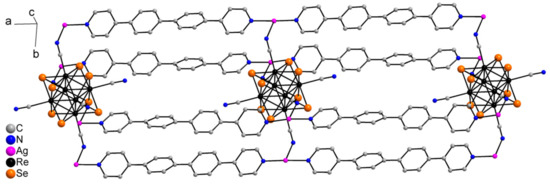
Figure 17.
1D fragment of compound 5.
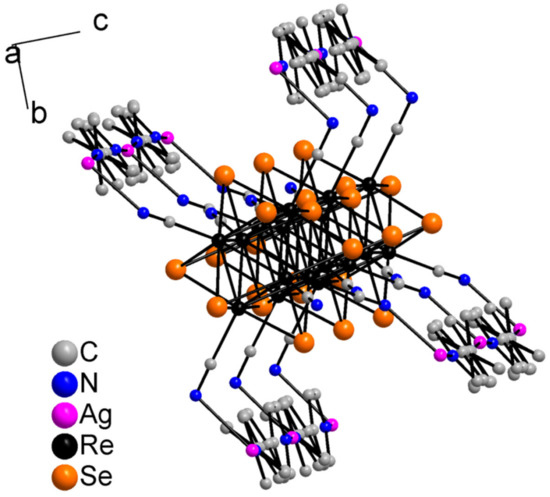
Figure 18.
1D fragment of compound 5 along a axis.
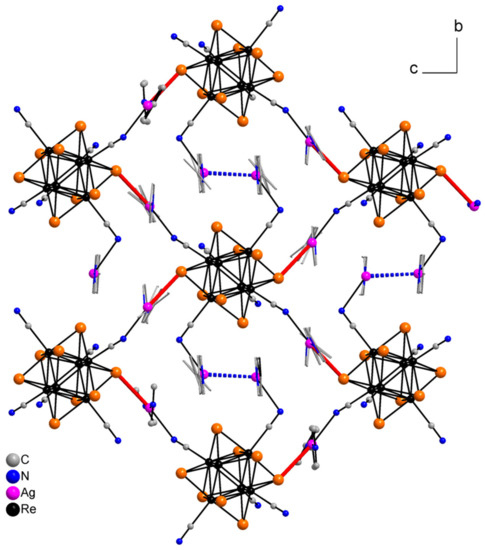
Figure 19.
A framework fragment of compound 5.
4,4′-Di(4-pyridyl)biphenyl is not a common ligand for the synthesis of coordination compounds. In the literature, there are about 30 examples of coordination polymers based on this ligand and 3d metal cations. Moreover, among them there are no examples of compounds with the metals of group 11 except two examples of compounds with copper cations [62,63]. The conditions for the synthesis of compounds 4–6 were similar. However, compound 4 formed after a long stay of the sealed ampoule in the dark after heating, while the crystalline product for compounds 5 and 6 began to form after 48 h in the furnace. The structures of compounds 4 and 5 also differ significantly. In both cases, linear chains [Ag(L)]+n were formed. However, in the case of compound 5, the cluster complex coordinated four such chains, while for compound 2, the coordination environment of the cluster complex included only two chains. In addition, as mentioned above, compound 4 had additional bridging silver atoms that did not include bipy molecules in their coordination environment. Moreover, the absence of π–π interactions for compound 5 is of interest. Each cluster complex in both compounds provided two selenium atoms for bonding with silver atoms.
3.3. Luminescence Properties
Luminescence properties of chalcocyanide complexes [{Re6Q8}(CN)6]4− (Q = S, Se or Te) were studied in solution and in the solid state. The tellurocyanide cluster complex shows negligible luminescence while sulfido- and selenocyanide clusters brightly emit in visible and near-infrared regions upon ultraviolet light excitation [3]. It was shown that some coordination polymers based on cluster anions [Re6Q8(CN)6]4− and transition metal cations possess luminescence properties typical for the chalcocyanide cluster complexes [12,23,64,65]. It is noteworthy that, in the luminescence spectra the coordination polymers based on the cluster anions and lanthanide cations usually only a broad band of the corresponding cyanide cluster complex is presented without lanthanides emission bands, and the luminescence is often much weaker than that of starting alkali metal salts of the clusters [7,64]. Two coordination polymers, namely [{Ag(bpy)}{Ag4(bpy)4(µ-CN)}{Re6Q8(CN)6}] (Q = S or S), were the first [Re6Q8(CN)6]4−-based coordination polymers for which luminescence characteristics comparable with the parent cluster salts were reported [21]. Emission spectra of the compounds 1, 2, 5 and 6 show the emission band characteristic of [Re6Q8(CN)6]4− clusters without noticeable contribution from the Ag+ complex with ligand (Figure 20). Emission lifetimes and quantum yields for compounds 5 and 6 are comparable with parent compounds (Bu4N)4[Re6Q8(CN)6] (Q = S, Se). But compounds 1 and 2 possess more impressive photophysical characteristics (Table 1).
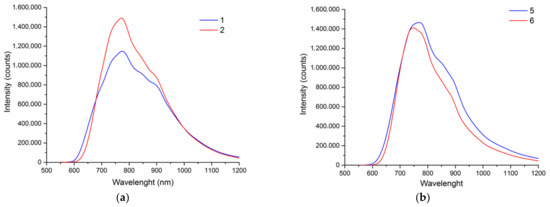
Figure 20.
Emission spectra of: (a) 1 (λem = 775 nm) and 2 (λem = 770 nm); (b) 5 (λem = 762 nm) and 6 (λem = 746 nm).

Table 1.
Spectroscopic and photophysical data of the solid samples of 1, 2, 5 and 6 and the parent compounds.
Complexes of Ag+ are known for their luminescence properties. N-donor conjugated molecules bonded to Ag+ cation increase their conformational rigidity leading to the reduction in energy loss by intramolecular vibrational and rotational motions and, as a result, to enhanced luminescence [22]. Moreover, the nature of the luminescence is determined by the ligand structure and the structure of obtained metal complex. Emission bands of free 1,10-phen and dpbp (Figure 21 and Figure 22) are located in the wavelength region 350–500 nm and overlap with excitation spectra of the chalcocyanide cluster complexes, which cover the wavelength region from 210 to more than 500 nm. Thus, there is every reason to assert that intense and long-lived emission of compounds 1, 2, 5 and 6 can be attributed to the Förster Resonance Energy Transfer (FRET) mechanism with the Ag+ complex acting as donor and cluster anion as the acceptor because of the mentioned overlap of their emission and excitation spectra.
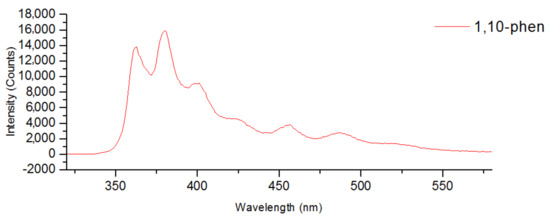
Figure 21.
Emission spectrum of 1,10-phen.
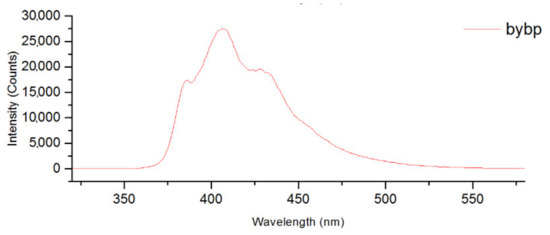
Figure 22.
Emission spectrum of dpbp.
4. Conclusions
In conclusion, we have obtained 6 new coordination compounds based on Ag+ cations and [Re6Q8(CN)6]4− cluster anions (Q = S or Se) with various N- heterocyclic aromatic ligands. The resulting compounds have both 2D and 3D structures. Investigation of luminescence properties of the new compounds showed they all demonstrate a broad emission band of the corresponding chalcocyanide {Re6} cluster. Photophysical characteristics of compounds 5 and 6 are comparable with parent compounds (Bu4N)4[Re6Q8(CN)6] (Q = S, Se). Emission lifetimes and quantum yields of 1 and 2 are much higher than those of the parent compounds. In addition, these compounds exhibit the highest photophysical characteristics among coordination polymers based on the cluster complexes [Re6Q8(CN)6]4− with 3d and 4f metals. This work has shown that the use of Ag+ cations coordinated by heterocyclic N-donor ligands as components of coordination polymers based on rhenium cluster complexes makes it possible to obtain polymeric materials with bright cluster-based red emission. Most importantly, the emission lifetimes and quantum yields for the polymers in some cases exceed those for discrete cluster ions. Further development of this chemistry may result in obtaining new luminescent coordination polymers, which are potentially applicable as multifunctional materials.
Supplementary Materials
The following supporting information can be downloaded at: https://www.mdpi.com/article/10.3390/molecules27227684/s1. Crystal data and structure refinement and the main geometric characteristics of the compounds are available online in Tables S1–S8.
Author Contributions
Realization of the experiments and analysis of the experimental data, Y.M.L.; investigation of crystal structures, T.S.S.; analysis of luminescence properties, K.A.B.; writing, Y.M.L.; writing—review & editing, Y.M.G., Y.V.M. and K.A.B. All authors have read and agreed to the published version of the manuscript.
Funding
This work is supported by the grant of Russian Science Foundation (project 19-73-20196) and Ministry of Science and Higher Education of the Russian Federation: 121031700321-3.
Institutional Review Board Statement
Not applicable.
Informed Consent Statement
Not applicable.
Data Availability Statement
Data are contained within the article and Supplementary Materials.
Acknowledgments
Some experimental measurements were performed in “Center for Optical and Laser materials research” (St. Petersburg State University, St. Petersburg, Russian Federation). Authors are grateful for data collection performed in XRD Facility of NIIC SBRAS.
Conflicts of Interest
The authors declare no conflict of interest.
References
- Beauvais, L.G.; Shores, M.P.; Long, J.R. Cyano-Bridged Re6Q8 (Q = S, Se) Cluster-Cobalt(II) Framework Materials: Versatile Solid Chemical Sensors. J. Am. Chem. Soc. 2000, 122, 2763–2772. [Google Scholar] [CrossRef]
- Ulantikov, A.A.; Gayfulin, Y.M.; Sukhikh, T.S.; Ryadun, A.A.; Ryzhikov, M.R.; Mironov, Y.V. Synthesis, Structure, and Physicochemical Properties of Molecular Rhenium Cluster Complexes with 4-Phenylpyridine Molecules as Terminal Ligands. J. Struct. Chem. 2021, 62, 1009–1019. [Google Scholar] [CrossRef]
- Elistratova, J.; Akhmadeev, B.; Gubaidullin, A.; Shestopalov, M.A.; Solovieva, A.; Brylev, K.; Kholin, K.; Nizameev, I.; Ismaev, I.; Kadirov, M.; et al. Structure Optimization for Enhanced Luminescent and Paramagnetic Properties of Hydrophilic Nanomaterial Based on Heterometallic Gd-Re Complexes. Mater. Des. 2018, 146, 49–56. [Google Scholar] [CrossRef]
- Stass, D.V.; Vorotnikova, N.A.; Shestopalov, M.A. Direct Observation of X-Ray Excited Optical Luminescence from a Re6 Metal Cluster in True Aqueous Solution: The Missing Link Between Material Characterization and In Vivo Applications. J. Appl. Phys. 2021, 129, 183102. [Google Scholar] [CrossRef]
- Yoshimura, T.; Ishizaka, S.; Sasaki, Y.; Kim, H.-B.; Kitamura, N.; Naumov, N.G.; Sokolov, M.N.; Fedorov, V.E. Unusual Capping Chalcogenide Dependence of the Luminescence Quantum Yield of the Hexarhenium(III) Cyano Complexes [Re6(μ3-E)8(CN)6]4−, E2− = Se2− > S2− > Te2−. Chem. Lett. 1999, 28, 1121–1122. [Google Scholar] [CrossRef]
- Larina, T.V.; Ikorskii, V.N.; Vasenin, N.T.; Anufrienko, V.F.; Naumov, N.G.; Ostanina, E.V.; Fedorov, V.E. Electronic State of Rhenium Complexes with Octahedral Chalcocyanide Cluster Anions [Re6Q8(CN)6]3− (Q = S, Se, Te). EPR and Magnetic Susceptibility Studies. Russ. J. Coord. Chem. 2002, 28, 554–556. [Google Scholar] [CrossRef]
- Litvinova, Y.M.; Gayfulin, Y.M.; Kovalenko, K.A.; Samsonenko, D.G.; van Leusen, J.; Korolkov, I.V.; Fedin, V.P.; Mironov, Y.V. Multifunctional Metal–Organic Frameworks Based on Redox-Active Rhenium Octahedral Clusters. Inorg. Chem. 2018, 57, 2072–2084. [Google Scholar] [CrossRef]
- Artemkina, S.B.; Naumov, N.G.; Virovets, A.V.; Gromilov, S.A.; Fenske, D.; Fedorov, V.E. New Polymeric Structure of Rhenium Octahedral Chalcocyanide Complex: Ln3+-Derived Network with One-Dimensional Channels. Inorg. Chem. Commun. 2001, 4, 423–426. [Google Scholar] [CrossRef]
- Ermolaev, A.V.; Smolentsev, A.I.; Mironov, Y.V. Use of [Re6Q8(CN)6]4− (Q = S, Se, Te) Cluster Anions and Cu(I) Cationic Complexes with 2,2′-Bipyridine for the Construction of New Cyano-Bridged Coordination Compounds. Polyhedron 2015, 102, 417–423. [Google Scholar] [CrossRef]
- Mironov, Y.V.; Virovets, A.V.; Sheldrick, W.S.; Fedorov, V.E. Novel Inorganic Polymeric Compounds Based on the Re4 Chalcocyanide Cluster Complexes: Synthesis and Crystal Structures of Mn2[Re4Se4(CN)12]·6H2O, Cd2[Re4Te4(CN)12]·6H2O, Cu2[Re4Te4(CN)12]·4H2O and K4Re4Se4(CN)12·6H2O. Polyhedron 2001, 20, 969–974. [Google Scholar] [CrossRef]
- Tarasenko, M.S.; Naumov, N.G.; Naumov, D.Y.; Kim, S.-J.; Fedorov, V.E. A Series of Three-Dimensional Coordination Polymers with General Formula [{Ln(H2O)n}{Re6Te8(CN)6}]·xH2O (Ln = Eu, Gd, Tb, Dy, Ho, Er, Tm, Yb; n = 3, 4, x = 0, 2.5). Polyhedron 2008, 27, 2357–2364. [Google Scholar] [CrossRef]
- Litvinova, Y.M.; Gayfulin, Y.M.; Van Leusen, J.; Samsonenko, D.G.; Lazarenko, V.A.; Zubavichus, Y.V.; Kögerler, P.; Mironov, Y.V. Metal-Organic Frameworks Based on Polynuclear Lanthanide Complexes and Octahedral Rhenium Clusters. Inorg. Chem. Front. 2019, 6, 1518–1526. [Google Scholar] [CrossRef]
- Niu, G.-H.; Wentz, H.C.; Zheng, S.-L.; Campbell, M.G. Silver(I) Coordination Polymers from Dinucleating Naphthyridine Ligands. Inorg. Chem. Commun. 2019, 101, 142–144. [Google Scholar] [CrossRef]
- Medici, S.; Peana, M.; Crisponi, G.; Nurchi, V.M.; Lachowicz, J.I.; Remelli, M.; Zoroddu, M.A. Silver Coordination Compounds: A New Horizon in Medicine. Coord. Chem. Rev. 2016, 327–328, 349–359. [Google Scholar] [CrossRef]
- Hamze, R.; Shi, S.; Kapper, S.C.; Muthiah Ravinson, D.S.; Estergreen, L.; Jung, M.-C.; Tadle, A.C.; Haiges, R.; Djurovich, P.I.; Peltier, J.L.; et al. “Quick-Silver” from a Systematic Study of Highly Luminescent, Two-Coordinate, d10 Coinage Metal Complexes. J. Am. Chem. Soc. 2019, 141, 8616–8626. [Google Scholar] [CrossRef]
- Kakizoe, D.; Nishikawa, M.; Degawa, T.; Tsubomura, T. Intense Blue Emission and a Reversible Hypsochromic Shift of Luminescence Caused by Grinding Based on Silver(I) Complexes. Inorg. Chem. Front. 2016, 3, 1381–1387. [Google Scholar] [CrossRef]
- Romanov, A.S.; Jones, S.T.E.; Yang, L.; Conaghan, P.J.; Di, D.; Linnolahti, M.; Credgington, D.; Bochmann, M. Mononuclear Silver Complexes for Efficient Solution and Vacuum-Processed OLEDs. Adv. Opt. Mater. 2018, 6, 1801347. [Google Scholar] [CrossRef]
- Lin, Y.-Y.; Lai, S.-W.; Che, C.-M.; Fu, W.F.; Zhou, Z.-Y.; Zhu, N. Structural Variations and Spectroscopic Properties of Luminescent Mono- and Multinuclear Silver(I) and Copper(I) Complexes Bearing Phosphine and Cyanide Ligands. Inorg. Chem. 2005, 44, 1511–1524. [Google Scholar] [CrossRef]
- Schmidbaur, H.; Schier, A. Argentophilic Interactions. Angew. Chem. Int. Ed. 2015, 54, 746–784. [Google Scholar] [CrossRef]
- Wing-Wah Yam, V.; Kam-Wing Lo, K.; Kit-Mai Fung, W.; Wang, C.-R. Design of Luminescent Polynuclear Copper(I) and Silver(I) Complexes with Chalcogenides and Acetylides as the Bridging Ligands. Coord. Chem. Rev. 1998, 171, 17–41. [Google Scholar] [CrossRef]
- Yersin, H.; Czerwieniec, R.; Shafikov, M.Z.; Suleymanova, A.F. TADF Material Design: Photophysical Background and Case Studies Focusing on Cu(I) and Ag(I) Complexes, in: Highly Efficient OLEDs. ChemPhysChem 2018, 18, 1–60. [Google Scholar] [CrossRef]
- Njogu, E.M.; Omondi, B.; Nyamori, V.O. Review: Multimetallic Silver(I)–Pyridinyl Complexes: Coordination of Silver(I) and Luminescence. J. Coord. Chem. 2015, 68, 3389–3431. [Google Scholar] [CrossRef]
- Ermolaev, A.V.; Smolentsev, A.I.; Brylev, K.A.; Kitamura, N.; Mironov, Y.V. First Cyano-Bridged Coordination Polymers Based on N,N′-Chelated Ag(I) Ions and Octahedral Rhenium(III) Chalcocyanide Clusters Exhibiting Unusually Long-Lived Photoluminescence. J. Mol. Struct. 2018, 1173, 627–634. [Google Scholar] [CrossRef]
- Mironov, Y.V.; Virovets, A.V.; Fedorov, V.E.; Podberezskaya, N.V.; Shishkin, O.V.; Struchkov, Y.T. Synthesis and Crystal Structure of a Hexanuclear Rhenium Cluster Complex Cs3K[Re6(μ3-S)6(μ3-Te0.66S0.34)2(CN)6]. Cationic Control over Orientation of the Cluster Anion. Polyhedron 1995, 14, 3171–3173. [Google Scholar] [CrossRef]
- Naumov, N.G.; Virovets, A.V.; Podberezskaya, N.V.; Fedorov, V.E. Synthesis and Crystal Structure of K4[Re6Se8(CN)6]·3.5H2O. J. Struct. Chem. 1997, 38, 857–862. [Google Scholar] [CrossRef]
- Sheldrick, G. SADABS, Program for Empirical Absorption Correction of Area Detector Data; ScienceOpen, Inc.: Burlington, MA, USA, 1996. [Google Scholar]
- Sheldrick, G.M. SHELXT—Integrated Space-Group And Crystal-Structure Determination. Acta Crystallogr. Sect. A Found. Crystallogr. 2015, 71, 3–8. [Google Scholar] [CrossRef]
- Sheldrick, G. Crystal Structure Refinement with SHELXL. Acta Crystallogr. C 2015, 71, 3–8. [Google Scholar] [CrossRef]
- CrysAlisPro 1.171.38.41; Rigaku Oxford Diraction: The Woodlands, TX, USA, 2018.
- Comte, V.; Chen, Z.-N.; Flay, M.-L.; Vahrenkamp, H. Oligonuclear Cyanide Complexes from Silver Containing Building Blocks. J. Organomet. Chem. 2000, 614–615, 131–136. [Google Scholar] [CrossRef]
- Krawczyk, M.K.; Bikas, R.; Krawczyk, M.S.; Lis, T. On Rhenium(I)-Silver(I) Cyanide Porous Macrocyclic Clusters. CrystEngComm 2017, 19, 3138–3144. [Google Scholar] [CrossRef]
- Artemkina, S.B.; Naumov, N.G.; Mironov, Y.V.; Sheldrick, W.S.; Virovets, A.V.; Fenske, D. Electroneutral Coordination Frameworks Based on Octahedral [Re6(μ3-Q)8(CN)6]4− complexes (Q = S, Se, Te) and the Mn2+ Cations. Russ. J. Coord. Chem. 2007, 33, 867–875. [Google Scholar] [CrossRef]
- Dias, H.V.R.; Diyabalanage, H.; Jayaratna, N.B.; Shaw, D.; Hettiarachchi, C.V.; Parasar, D. Dinuclear and Trinuclear Complexes of Copper(I) and Silver(I) Supported by a Highly Fluorinated Pyrazolate [3,5-(CF3)2Pz]− and N-Heterocycles. Eur. J. Inorg. Chem. 2019, 2019, 3638–3644. [Google Scholar] [CrossRef]
- Shafikov, M.Z.; Czerwieniec, R.; Yersin, H. Ag(I) Complex Design Affording Intense Phosphorescence with a Landmark Lifetime of Over 100 Milliseconds. Dalton Trans. 2019, 48, 2802–2806. [Google Scholar] [CrossRef]
- Titov, A.A.; Filippov, O.A.; Smol’yakov, A.F.; Averin, A.A.; Shubina, E.S. Synthesis, Structures and Luminescence of Multinuclear Silver(I) Pyrazolate Adducts with 1,10-Phenanthroline Derivatives. Dalton Trans. 2019, 48, 8410–8417. [Google Scholar] [CrossRef]
- Chen, W.-H.; Hu, Z.-B.; Zhang, Z.-S.; You, L.-X.; Xie, S.-J.; Yuan, Q.-L.; Zhao, J.-H.; Huang, T.-F.; Mi, J.-X. A New Wells–Dawson Organic–Inorganic Hybrid Polytungstate Containing Dimeric Silver Coordination Complexes: (Hpy)2[Ag2(phen)4]2(P2W18O62). J. Coord. Chem. 2014, 67, 2583–2594. [Google Scholar] [CrossRef]
- Effendy; Marchetti, F.; Pettinari, C.; Pettinari, R.; Skelton, B.W.; White, A.H. Synthesis and Structural Characterization of Adducts of Silver(I) Oxyanion Salts, AgX (X = ClO4, NO3), with Ph2E(CH2)xEPh2 (‘dpex’; E=P, As; x=1–3) and Oligodentate Aromatic N-Bases Derivative of 2,2′-Bipyridyl, ‘L’, AgX:dpex:L (2:1:1) or (1:1:1). Inorg. Chim. Acta 2007, 360, 1414–1423. [Google Scholar] [CrossRef]
- Kaeser, A.; Delavaux-Nicot, B.; Duhayon, C.; Coppel, Y.; Nierengarten, J.-F. Heteroleptic Silver(I) Complexes Prepared from Phenanthroline and Bis-phosphine Ligands. Inorg. Chem. 2013, 52, 14343–14354. [Google Scholar] [CrossRef]
- Krishna, H.; Krishnamurthy, S.S.; Nethaji, M. Synthesis and Structural Characterization of Mixed-Ligand Silver(I) Complexes Containing Diphosphazanes and Bidentate N-Donor Ligands. Inorg. Chim. Acta 2009, 362, 38–42. [Google Scholar] [CrossRef]
- Lin, Y.-M.; Guan, Z.-J.; Liu, K.-G.; Jiang, Z.-G.; Wang, Q.-M. Assembly of Silver Alkynyl Compounds with Various Nuclearities. Dalton Trans. 2015, 44, 2439–2446. [Google Scholar] [CrossRef]
- Wu, H.-B.; Huang, Z.-J.; Wang, Q.-M. Unprecedented Solution-Stable Silver(I) Ethynediyl Clusters. Chem. Eur. J. 2010, 16, 12321–12323. [Google Scholar] [CrossRef]
- Jian, F.; Xiao, H.; Sun, P. Structure of bis(O,O′-dialkyldithio-phosphato) Dimeric Silver(I) with bis(1,10-phenanthroline): Ag2[(PhO)2PS2]4(Phen)2 and Ag2[(PrO)2PS2]4(Phen)2. Asian J. Chem. 2007, 19, 1141–1147. [Google Scholar]
- Jian, F.; Xiao, H.; Wang, H. Synthesis and Crystal Structure of Dimeric Silver(I) Complex: Ag2[phen]2[S2P(OPr)2]2. Indian J. Chem. Sect. A Inorg. Phys. Theor. Anal. Chem. 2004, 43, 1659–1661. [Google Scholar]
- Yang, Q.-H.; Xie, B.; He, L.-X.; Wang, J.; Li, Y.-L.; Wu, Y. Syntheses, Characterizations, and Crystal Structures of two Binuclear Silver Complexes Based on O,O′-dialkyldithiophosphate and 1,10-phenanthroline. Chin. J. Struct. Chem. 2014, 33, 1215–1221. [Google Scholar]
- Jakob, A.; Rüffer, T.; Schmidt, H.; Djiele, P.; Körbitz, K.; Ecorchard, P.; Haase, T.; Kohse-Höinghaus, K.; Frühauf, S.; Wächtler, T.; et al. Disilver(I) Coordination Complexes: Synthesis, Reaction Chemistry, and Their Potential Use in CVD and Spin-Coating Processes for Silver Deposition. Eur. J. Inorg. Chem. 2010, 2010, 2975–2986. [Google Scholar] [CrossRef]
- Marinescu, G.; Lescouëzec, R.; Armentano, D.; De Munno, G.; Andruh, M.; Uriel, S.; Llusar, R.; Lloret, F.; Julve, M. [Cr(bpym)(C2O4)2]− in Designing Heterometallic Complexes. Crystal Structures and Magnetic Properties of PPh4[Cr(bpym)(C2O4)2]·H2O and [Ag(bpym)][Cr(C2O4)2](H2O)2]·2H2O (bpym = 2,2′-bipyrimidine). Inorg. Chim. Acta 2002, 336, 46–54. [Google Scholar] [CrossRef]
- Massoud, A.a.A.; Langer, V.; Gohar, Y.M.; Abu-Youssef, M.A.M.; Jänis, J.; Öhrström, L. 2D Bipyrimidine Silver(I) Nitrate: Synthesis, X-Ray Structure, Solution Chemistry and Anti-Microbial Activity. Inorg. Chem. Commun. 2011, 14, 550–553. [Google Scholar] [CrossRef]
- Pointillart, F.; Herson, P.; Boubekeur, K.; Train, C. Square-Planar and Trigonal Prismatic Silver(I) in Bipyrimidine and Oxalate Bridged Tetranuclear Complexes and One-Dimensional Compounds: Synthesis and Crystal Structures. Inorg. Chim. Acta 2008, 361, 373–379. [Google Scholar] [CrossRef]
- Moussa, M.E.; Attenberger, B.; Fleischmann, M.; Schreiner, A.; Scheer, M. The Diphosphorus Complex [Cp2Mo2(CO)4(η2-P2)] as a Building Block for the Synthesis of Mixed-Hybrid Coordination Polymers. Eur. J. Inorg. Chem. 2016, 2016, 4538–4541. [Google Scholar] [CrossRef]
- Dong, X.-W.; Wu, H.; Feng, Y.; Ma, C.-H.; Wang, X.-Y.; Li, Y.-J. Syntheses, Structures and Luminescence of Silver(I) Sulfonate Complexes with Nitrogen-Containing Ligands. J. Mol. Struct. 2014, 1074, 516–521. [Google Scholar] [CrossRef]
- Li, F.; Li, T.; Yuan, D.; Lv, J.; Cao, R. Characterization of a Novel Water Tape Containing (H2O)18 Clusters. Inorg. Chem. Commun. 2006, 9, 691–694. [Google Scholar] [CrossRef]
- Li, B.; Zang, S.-Q.; Ji, C.; Du, C.-X.; Hou, H.-W.; Mak, T.C.W. Syntheses, Structures and Properties of two Unusual Silver–Organic Coordination Networks: 1D→1D Tubular Intertwinement and Existence of an Infinite Winding Water Chain. Dalton Trans. 2011, 40, 788–792. [Google Scholar] [CrossRef]
- Sun, D.; Liu, F.-J.; Hao, H.-J.; Huang, R.-B.; Zheng, L.-S. Different Water Clusters Dependent on Long-Chain Dicarboxylates in Two Ag(I) Coordination Polymers: Synthesis, Structure and Thermal Stability. J. Mol. Struct. 2011, 1004, 313–318. [Google Scholar] [CrossRef]
- Wu, H.; Dong, X.-W.; Liu, H.-Y.; Ma, J.-F.; Li, S.-L.; Yang, J.; Liu, Y.-Y.; Su, Z.-M. Influence of Anionic Sulfonate-Containing Co-Ligands on the Solid Structures of Silver Complexes Supported by 4,4′-Bipyridine Bridges. Dalton Trans. 2008, 39, 5331–5341. [Google Scholar] [CrossRef]
- Li, T.; Huang, X.-H.; Zhao, Y.-F.; Li, H.-H.; Wu, S.-T.; Huang, C.-C. An Unusual Double T5(2) Water Tape Trapped in Silver(I) Coordination Polymer Hosts: Influence of the Solvent on the Assembly of Ag(I)-4,4′-Bipyridine Chains with Trans-Cyclohexanedicarboxylate and Their Luminescent Properties. Dalton Trans. 2012, 41, 12872–12881. [Google Scholar] [CrossRef]
- Liu, C.-S.; Wang, J.-J.; Chang, Z.; Yan, L.-F.; Hu, T.-L. Silver(I) Complexes with a Bulky Anthracene-Based Dicarboxylic Ligand: Syntheses, Crystal Structures, and Luminescent Properties. Z. Anorg. Allg. Chem. 2009, 635, 523–529. [Google Scholar] [CrossRef]
- Luo, G.-G.; Wu, D.-L.; Liu, L.; Xia, J.-X.; Li, D.-X.; Dai, J.-C.; Xiao, Z.-J. A Discrete Water Hexamer with a New Planar Tetrameric Water Moiety Trapped in the Crystal Host of [Ag(azelate)(4,4′-bipyridine)]·(H2O)3. J. Mol. Struct. 2011, 1005, 172–177. [Google Scholar] [CrossRef]
- Wu, X.-Q.; Wen, G.-X.; Wu, Y.-P.; Dong, W.-W.; Zhao, J.; Li, D.-S. A novel 3D Ag(I)-MOF: Surfactant-Directed Syntheses and Catalytic Degradation of o/m/p-Nitrophenol. J. Solid State Chem. 2016, 242, 243–247. [Google Scholar] [CrossRef]
- Yang, H.; Gao, S.; Lü, J.; Xu, B.; Lin, J.; Cao, R. pH-Dependent Syntheses and Crystal Structures of a Series of Organic–Inorganic Hybrids Constructed from Keggin or Wells–Dawson Polyoxometalates and Silver Coordination Compounds. Inorg. Chem. 2010, 49, 736–744. [Google Scholar] [CrossRef]
- Meng, J.; Li, Y.; Wang, X.; Wang, E. Synthesis, Crystal Structure, and Characterization of a New High-Dimensional Phosphomolybdate Architecture Built from Silver-Complex Fragments and Hexa-Connected P2Mo5 Clusters. J. Coord. Chem. 2009, 62, 2283–2289. [Google Scholar] [CrossRef]
- Sha, J.; Peng, J.; Pang, H.; Tian, A.; Chen, J.; Zhang, P.; Zhu, M. Assembly of Hexad-Track Ag–N Coordination Polymeric Chain-Modified Keggin Polyoxometalates. Solid State Sci. 2008, 10, 1491–1498. [Google Scholar] [CrossRef]
- Lu, Z.-Z.; Zhang, R.; Li, Y.-Z.; Guo, Z.-J.; Zheng, H.-G. [WS4Cu3I2]− and [WS4Cu4]2+ Secondary Building Units Formed a Metal–Organic Framework: Large Tubes in a Highly Interpenetrated System. Chem. Commun. 2011, 47, 2919–2921. [Google Scholar] [CrossRef] [PubMed]
- Ma, J.-P.; Yu, Y.; Dong, Y.-B. Fluorene-Based Cu(II)-MOF: A Visual Colorimetric Anion Sensor and Separator Based on an Anion-Exchange Approach. Chem. Commun. 2012, 48, 2946–2948. [Google Scholar] [CrossRef]
- Litvinova, Y.M.; Gayfulin, Y.M.; Brylev, K.A.; Piryazev, D.A.; van Leusen, J.; Kögerler, P.; Mironov, Y.V. Metal–Organic Frameworks with Solvent-Free Lanthanide Coordination Environments: Synthesis from Aqueous Ethanol Solutions. CrystEngComm 2020, 22, 7935–7943. [Google Scholar] [CrossRef]
- Gray, T.G.; Rudzinski, C.M.; Meyer, E.E.; Holm, R.H.; Nocera, D.G. Spectroscopic and Photophysical Properties of Hexanuclear Rhenium(III) Chalcogenide Clusters. J. Am. Chem. Soc. 2003, 125, 4755–4770. [Google Scholar] [CrossRef]
Publisher’s Note: MDPI stays neutral with regard to jurisdictional claims in published maps and institutional affiliations. |
© 2022 by the authors. Licensee MDPI, Basel, Switzerland. This article is an open access article distributed under the terms and conditions of the Creative Commons Attribution (CC BY) license (https://creativecommons.org/licenses/by/4.0/).